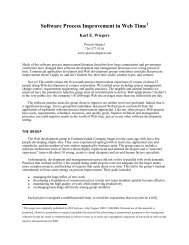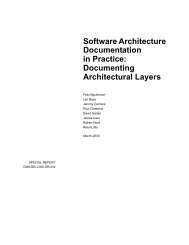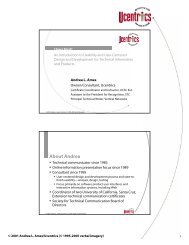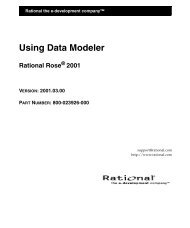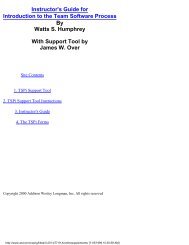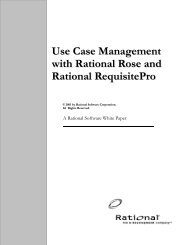RSI - A Structured Approach Use Cases and HCI Design
RSI - A Structured Approach Use Cases and HCI Design
RSI - A Structured Approach Use Cases and HCI Design
Create successful ePaper yourself
Turn your PDF publications into a flip-book with our unique Google optimized e-Paper software.
The <strong>RSI</strong> <strong>Approach</strong> To <strong>HCI</strong> <strong>Design</strong> / <strong>Use</strong> Case Analysis Page 5 of 42<br />
1. Introduction<br />
1.1. <strong>Use</strong> case analysis - Ivor Jacobson<br />
<strong>Use</strong> case analysis is a requirements capture technique that is most often used in the early<br />
stages of OO <strong>and</strong> component development projects. It was first introduced by Ivar Jacobson<br />
in his book "Object Oriented Software Engineering" [1], although the description of use case<br />
analysis presented in this book has, in practise, been interpreted in many different ways (one<br />
of the consequences of which is that, seemingly at least, no two use case analysis projects<br />
ever deliver the same information).<br />
Broadly speaking, use cases assist in defining the functional requirements of computer<br />
systems. Following is an example use case diagram:<br />
Manager<br />
W5a - <strong>RSI</strong> LONG PAPER [42 PAGES].doc( Rev: 5) - 03/09/00<br />
BACSNetwork<br />
CreateNewAccount<br />
SetOverdraftLimit<br />
BACSTransfers<br />
MonthlyOverdraftReport<br />
CreateNewCustomer<br />
TimerFacilities<br />
The use case diagram above is made up of the following elements:<br />
• a bounding box - showing the scope of the system under specification (the inner box in<br />
the diagram above).<br />
• a number of actors (stick men) representing the categories of users or systems which<br />
interact with the system under specification, in this case:<br />
– the manager of the bank<br />
– the clerks at the bank<br />
– the BACS network for inter-bank transfers, <strong>and</strong><br />
– automated timing facilities<br />
• a number of use cases (ovals) representing the 'business functions/processes' provided<br />
or supported by the system, in this case:<br />
– functions to set overdraft limits<br />
– functions to undertake BACS (automated inter-bank) transfers<br />
Clerk



